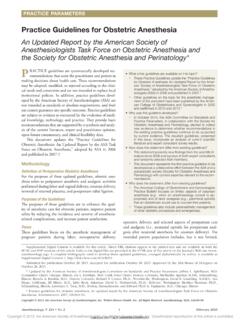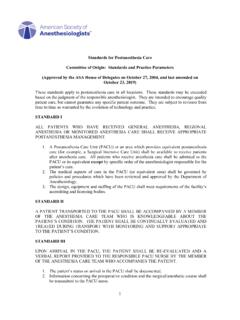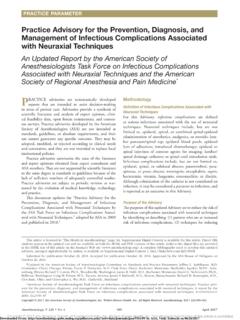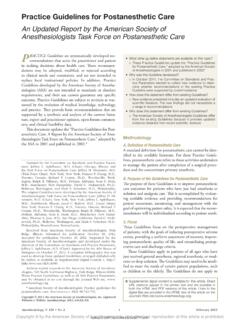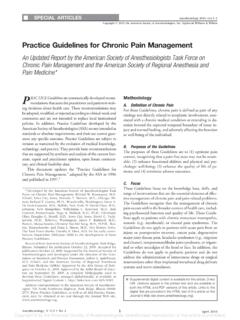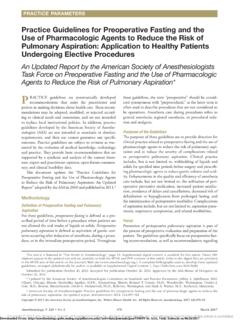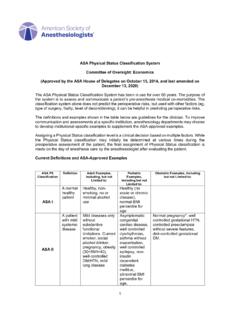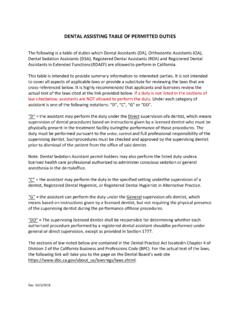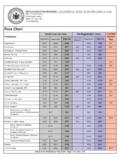Transcription of Practice Guidelines for Management of the Difficult Airway
1 Anesthesiology, V 118 No 2 1 February 2013 Practice Guidelines are systematically developed recommendations that assist the practitioner and patient in making decisions about health care. These recom-mendations may be adopted, modified, or rejected accord-ing to clinical needs and constraints and are not intended to replace local institutional policies. In addition, Practice Guidelines developed by the American Society of Anesthe-siologists (ASA) are not intended as standards or absolute requirements, and their use cannot guarantee any specific outcome.
2 Practice Guidelines are subject to revision as war-ranted by the evolution of medical knowledge, technology, and Practice . They provide basic recommendations that are supported by a synthesis and analysis of the current litera-ture, expert and practitioner opinion, open-forum commen-tary, and clinical feasibility document updates the Practice Guidelines for Management of the Difficult Airway : An Updated Report by the Task Force on Difficult Airway Management , adopted by the ASA in 2002 and published in 2003.
3 *MethodologyA. Definition of Difficult AirwayA standard definition of the Difficult Airway cannot be identi-fied in the available literature. For these Practice Guidelines , a Difficult Airway is defined as the clinical situation in which a conventionally trained anesthesiologist experiences difficulty with facemask ventilation of the upper Airway , difficulty with tracheal intubation, or both. The Difficult Airway represents a complex interaction between patient factors, the clinical setting, and the skills of the practitioner.
4 Analysis of this interaction requires precise collection and communication of data. The Task Force urges clinicians and investigators to use explicit descriptions of the Difficult Airway . Descriptions that can be categorized or expressed as numerical values are particularly desirable, because this type of information lends itself to aggregate analysis and cross-study comparisons. Suggested descriptions include, but are not limited to:Special articleSpractice Guidelines for Management of the Difficult airwayAn Updated Report by the American Society of Anesthesiologists Task Force on Management of the Difficult AirwayUpdated by the Committee on Standards and Practice Param-eters: Jeffrey L.
5 Apfelbaum, (Chair), Chicago, Illinois; Carin A. Hagberg, , Houston, Texas; and selected members of the Task Force on Management of the Difficult Airway : Robert A. Caplan, (Chair), Seattle, Washington; Casey D. Blitt, , Coronado, California; Richard T. Connis, , Woodinville, Washington; and David G. Nickinovich, , Bellevue, Washington. The previous update was developed by the American Society of Anesthesiolo-gists Task Force on Difficult Airway Management : Robert A. Caplan, (Chair), Seattle, Washington; Jonathan L.
6 Benumof, , San Diego, California; Frederic A. Berry, , Charlottesville, Virginia; Casey D. Blitt, , Tucson, Arizona; Robert H. Bode, , Bos-ton, Massachusetts; Frederick W. Cheney, , Seattle, Washington; Richard T. Connis, , Woodinville, Washington; Orin F. Guidry, , Jackson, Mississippi; David G. Nickinovich, , Bellevue, Washington; and Andranik Ovassapian, , Chicago, from American Society of Anesthesiologists, Park Ridge, Illinois. Submitted for publication October 18, 2012. Accepted for publication October 18, 2012.
7 Supported by the American Soci-ety of Anesthesiologists and developed under the direction of the Committee on Standards and Practice Parameters, Jeffrey L. Apfel-baum, (Chair). Approved by the ASA House of Delegates on October 17, 2012. A complete bibliography used to develop these updated Guidelines , arranged alphabetically by author, is available as Supplemental Digital Content 1, correspondence to the American Society of Anesthe-siologists: 520 N. Northwest Highway, Park Ridge, Illinois 60068 2573.
8 These Practice Guidelines , and all ASA Practice Parameters, may be obtained at no cost through the Journal Web site, *American Society of Anesthesiologists: Practice Guidelines for Management of the Difficult Airway : An updated report. Anesthesiology 2003; 98:1269 2013, the American Society of Anesthesiologists, Inc. Lippincott Williams & Wilkins. Anesthesiology 2013; 118:XX XX What other guideline statements are available on this topic? These Practice Guidelines update the Practice Guidelines for Management of the Difficult Airway , adopted by the American Society of Anesthesiologists in 2002 and pub-lished in 2003* Why was this Guideline developed?
9 In October 2011, the Committee on Standards and Prac-tice Parameters elected to collect new evidence to deter-mine whether recommendations in the existing Practice Guideline were supported by current evidence How does this statement differ from existing Guidelines ? New evidence presented includes an updated evaluation of scientific literature and findings from surveys of experts and randomly selected American Society of Anesthesiologists members. The new findings did not necessitate a change in recommendations Why does this statement differ from existing Guidelines ?
10 The American Society of Anesthesiologists Guidelines differ from the existing Guidelines because it provides updated evidence obtained from recent scientific literature and find-ings from new surveys of expert consultants and randomly selected American Society of Anesthesiologists membersALNP ractice GuidelinesPractice devi201320 Supplemental digital content is available for this article. Direct URL citations appear in the printed text and are available in both the HTML and PDF versions of this article.
